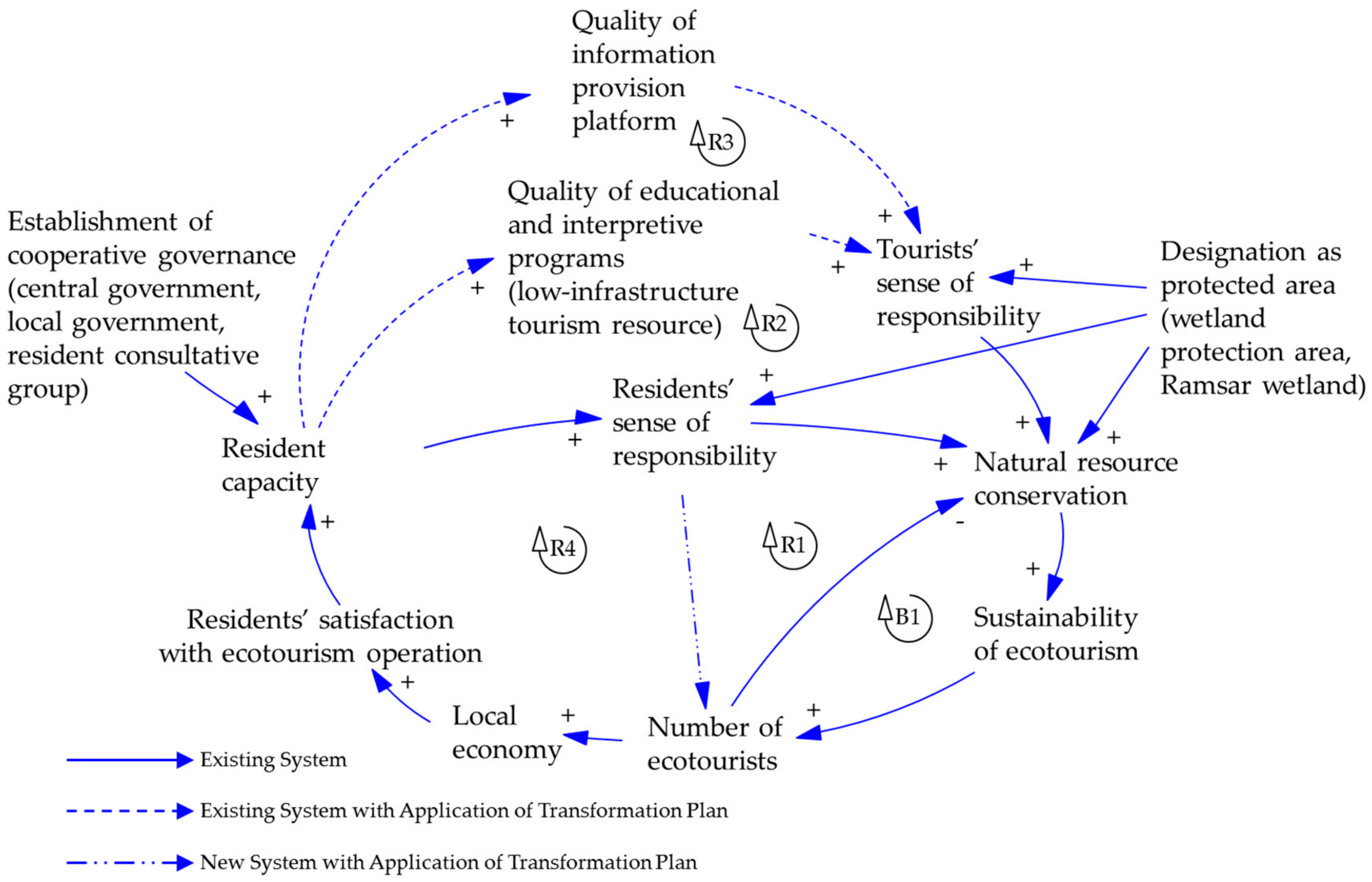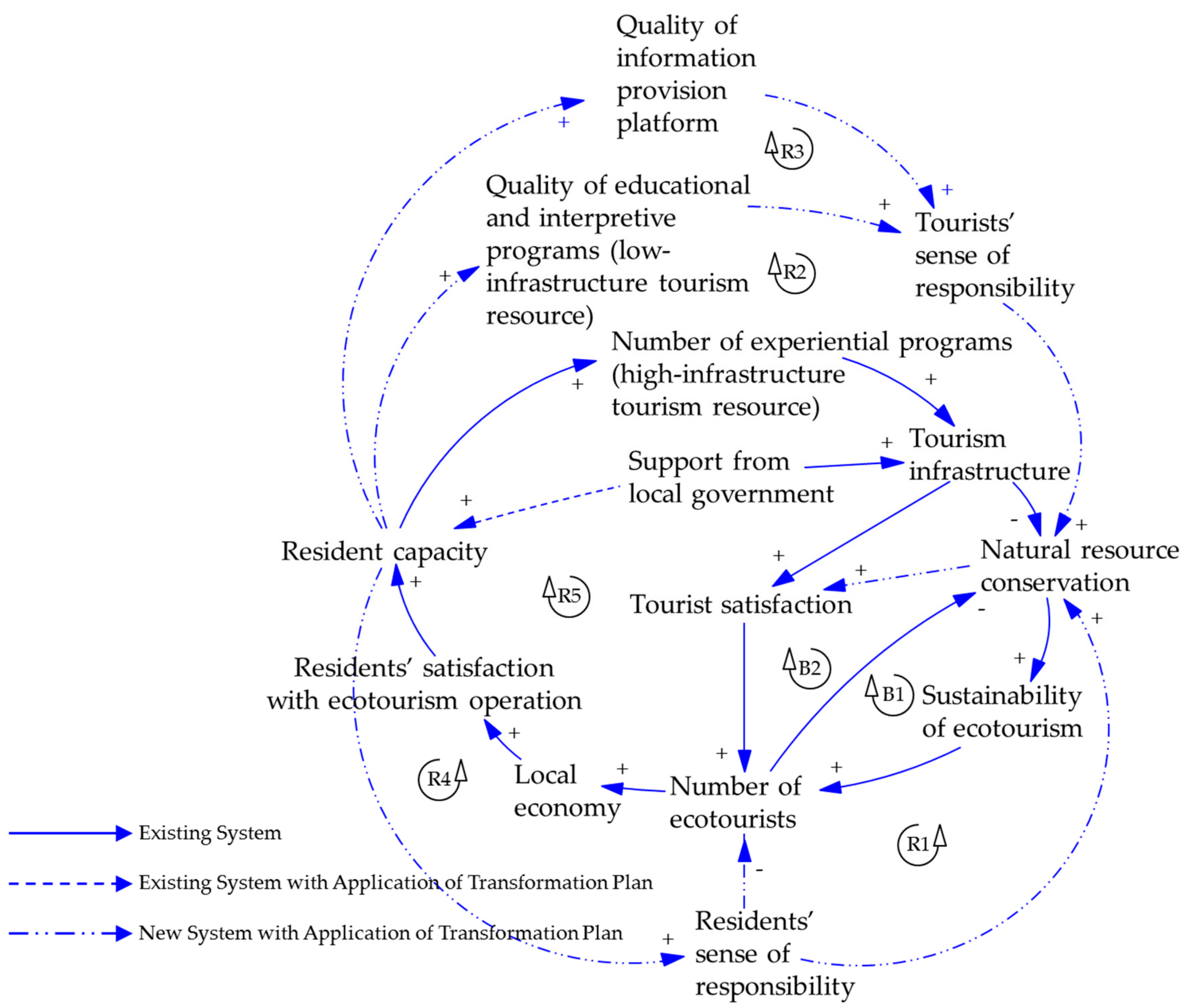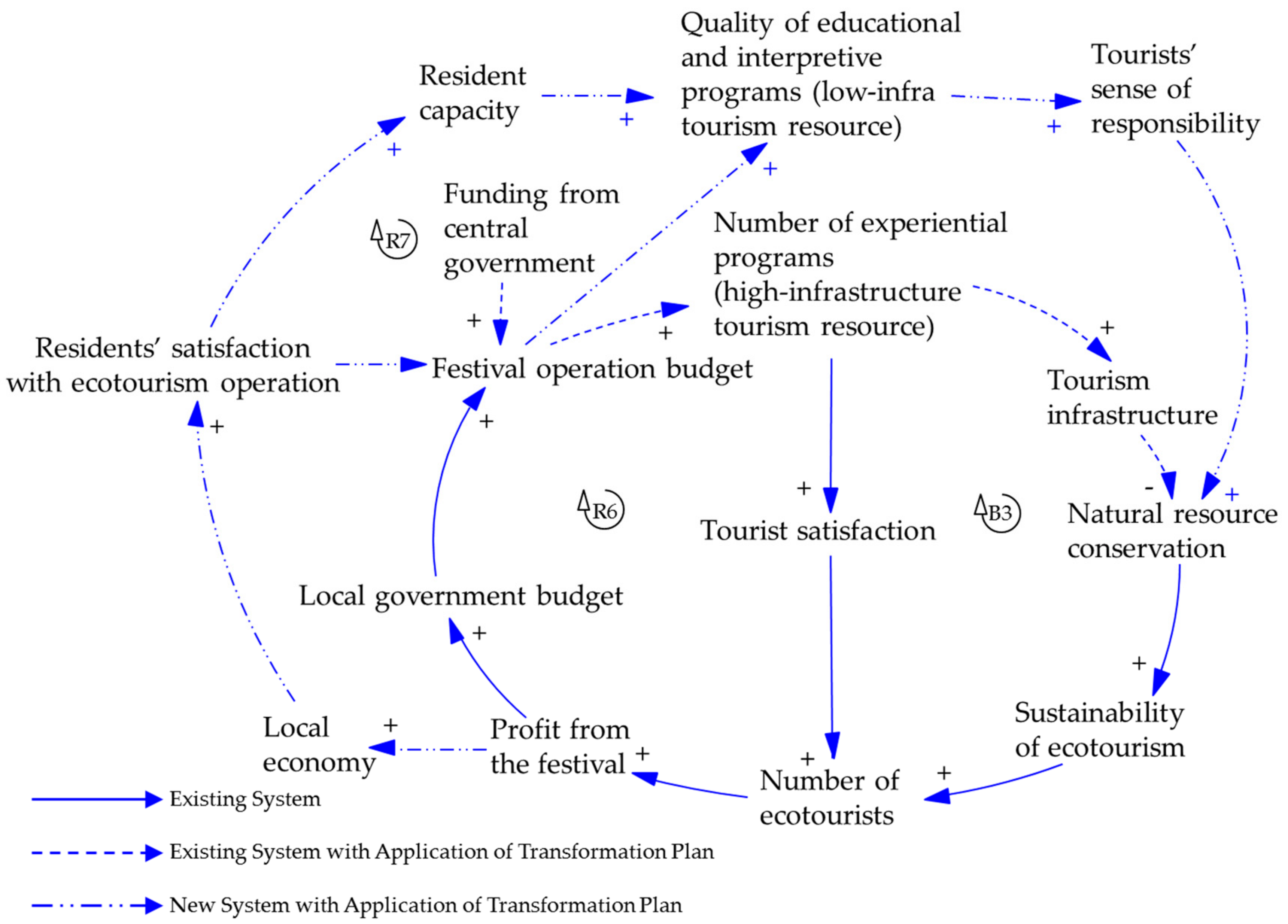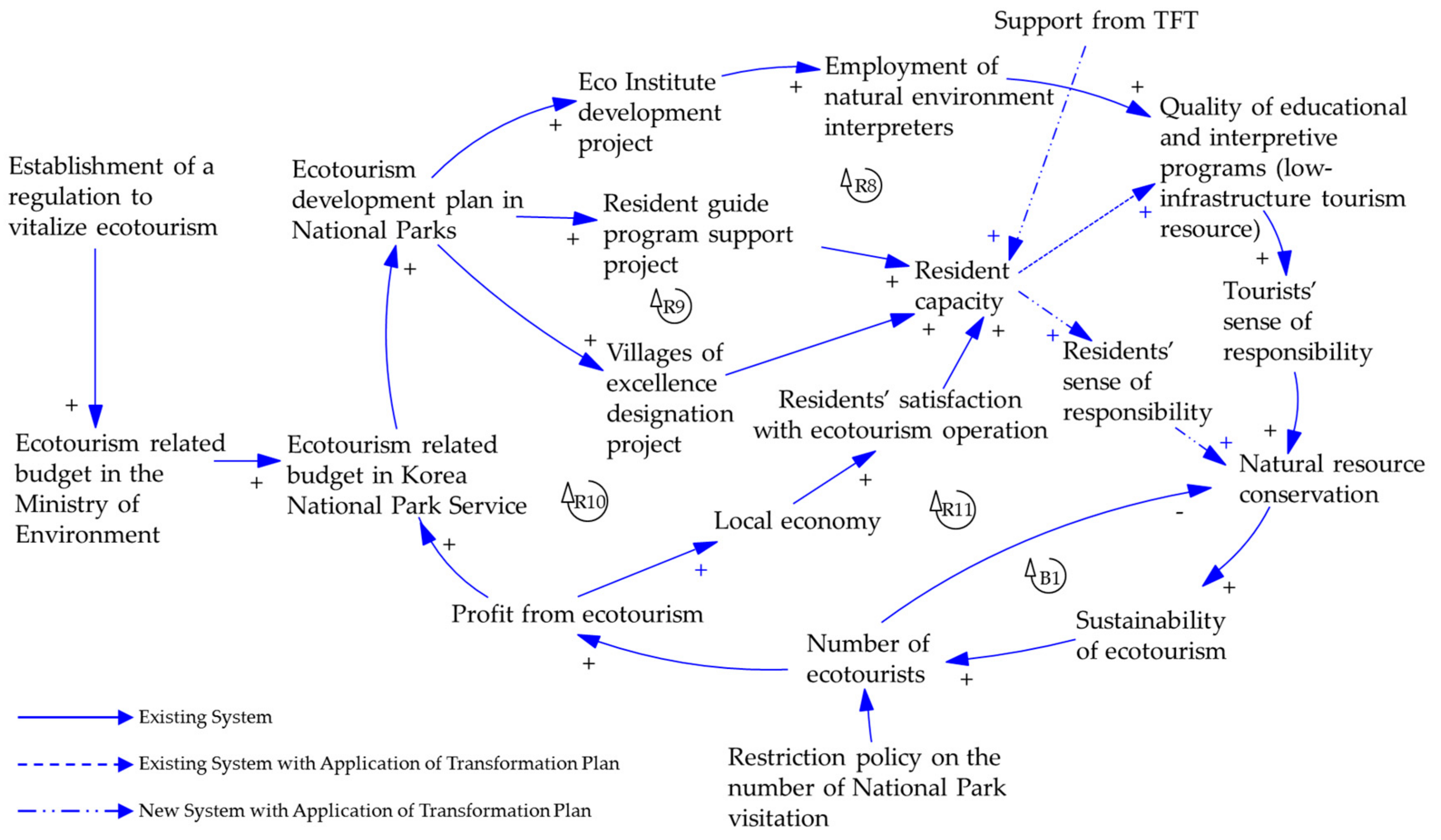Transformation Planning of Ecotourism Systems to Invigorate Responsible Tourism
Abstract
:1. Introduction
“responsible travel to natural areas that conserves the environment, sustains the well-being of the local people and involves interpretation and education”.[2]
2. Literature Review
2.1. Types of Ecotourism Systems
2.1.1. Low-Infrastructure and Resident-Initiated
2.1.2. High-Infrastructure and Resident-Initiated
2.1.3. High-Infrastructure and Government-Initiated
2.1.4. Low-Infrastructure and Government-Initiated
2.2. Considerations for Invigorating Responsible Tourism
3. Methods
3.1. Study Area
3.2. Research Method
4. Results and Discussion
4.1. Analysis of Low-Infrastructure and Resident-Initiated Ecotourism System: Case of Suncheon-si (City) Ecotourism Council
4.1.1. Analysis of Current Conditions of Suncheon-si Ecotourism Council Utilizing Dynamic Thinking
4.1.2. Main Variables of Low-Infrastructure and Resident-Initiated Ecotourism System Based on Causal Thinking and Causal Links among Them
4.1.3. Analysis of Causal Map of Low-Infrastructure and Resident-Initiated Ecotourism System Based on Feedback Thinking
4.1.4. Transformation Plan of Low-Infrastructure and Resident-Initiated Ecotourism System Based on Strategic Thinking
4.2. Analysis of High-Infrastructure and Resident-Initiated Ecotourism System: Case of Annam Fishing Village, Goheung-gun (County)
4.2.1. Analysis of Current Conditions of Goheung-gun Annam Fishing Village Utilizing Dynamic Thinking
4.2.2. Main Variables of the High-Infrastructure and Resident-Initiated Ecotourism System Based on Casual Thinking and Causal Links among Them
4.2.3. Analysis of Causal Map of High-Infrastructure and Resident-Initiated Ecotourism System Based on Feedback Thinking
4.2.4. Transformation Plan of the High-Infrastructure and Resident-Initiated Ecotourism System Based on Strategic Thinking
4.3. Analysis of High-Infrastructure and Government-Initiated Ecotourism System: Case of Hampyeong Butterfly Festival
4.3.1. Analysis of Current Conditions of Hampyeong Butterfly Festival Utilizing Dynamic Thinking
4.3.2. Main Variables of the High-Infrastructure and Government-Initiated Ecotourism System Based on Casual Thinking and Causal Links among Them
4.3.3. Analysis of the Causal Map of the High-Infrastructure and Government-Initiated Ecotourism System Based on Feedback Thinking
4.3.4. Transformation Plan of the High-Infrastructure and Government-Initiated Ecotourism System Based on Strategic Thinking
4.4. Analysis of the Low-Infrastructure and Government-Initiated Ecotourism System: The Case of Jirisan National Park
4.4.1. Analysis of the Current Conditions of the Jirisan National Park Utilizing Dynamic Thinking
4.4.2. Main Variables of the Low-Infrastructure and Government-Initiated Ecotourism System Based on Casual Thinking and Causal Links among Them
4.4.3. Analysis of the Causal Map of the Low-Infrastructure and Government-Initiated Ecotourism System Based on Feedback Thinking
4.4.4. Transformation Plan of the Low-Infrastructure and Government-Initiated Ecotourism System Based on Strategic Thinking
5. Conclusions
Acknowledgments
Author Contributions
Conflicts of Interest
References
- Ayala, H. Resort ecotourism: A master plan for experience management. Cornell Hotel Restaur. Adm. Q. 1996, 37, 54–61. [Google Scholar] [CrossRef]
- The International Ecotourism Society (TIES). Available online: http://www.ecotourism.org/what-is-ecotourism (accessed on 31 October 2017).
- Choi, Y.E.; Song, K.; Kim, M.; Lee, J. Transformation planning for resilient wildlife habitats in ecotourism systems. Sustainability 2017, 9, 487. [Google Scholar] [CrossRef]
- Kiss, A. Is community-based ecotourism a good use of biodiversity conservation funds? Trends Ecol. Evol. 2004, 19, 232–237. [Google Scholar] [CrossRef] [PubMed]
- Powell, R.B.; Ham, S.H. Can ecotourism interpretation really lead to pro-conservation knowledge, attitudes and behaviour? Evidence from the Galapagos Islands. J. Sustain. Tour. 2008, 16, 467–489. [Google Scholar] [CrossRef]
- Stem, C.J.; Lassoie, J.P.; Lee, D.R.; Deshler, D.D.; Schelhas, J.W. Community participation in ecotourism benefits: the link to conservation practices and perspectives. Soc. Nat. Resour. 2003, 16, 387–413. [Google Scholar] [CrossRef]
- Becker-Olsen, K.L.; Cudmore, B.A.; Hill, R.P. The impact of perceived corporate social responsibility on consumer behavior. J. Bus. Res. 2006, 59, 46–53. [Google Scholar] [CrossRef]
- Hall, C.M. Governance and Responsible Tourism. In Responsible Tourism: Concepts, Theory and Practice; Lesslie, D., Ed.; CABI: Oxfordshire, UK, 2012; pp. 107–118. [Google Scholar]
- Goodwin, H. Taking Responsibility for Tourism; Goodfellow Publishers, Limited: Woodeaton, UK, 2011. [Google Scholar]
- Leslie, D. The Responsible Tourism Debate. In Responsible Tourism: Concepts, Theory and Practice; Leslie, D., Ed.; CABI: Oxfordshire, UK, 2012; p. 23. [Google Scholar]
- Chiu, Y.-T.H.; Lee, W.-I.; Chen, T.-H. Environmentally responsible behavior in ecotourism: Antecedents and implications. Tour. Manag. 2014, 40, 321–329. [Google Scholar] [CrossRef]
- Choi, Y.; You, S.; Ham, E.; Song, K.; Chon, J. Sustainable management plan of eco-tourism resources using system thinking: a case study of Bamseom in Seoul. J. Tour. Sci. 2014, 38, 59–78. [Google Scholar]
- Fennell, D.A. Responsible tourism: A Kierkegaardian interpretation. Tour. Recreat. Res. 2008, 33, 3–12. [Google Scholar] [CrossRef]
- Wearing, S.; Neil, J. Ecotourism: Impacts, Potentials and Possibilities; Routledge: London, UK, 2009. [Google Scholar]
- Timothy, D. Destination Communities and Responsible Tourism. In Responsible Tourism: Concepts, Theory and Practice; Leslie, D., Ed.; CABI: Oxfordshire, UK, 2012; p. 77. [Google Scholar]
- Bookbinder, M.P.; Dinerstein, E.; Rijal, A.; Cauley, H.; Rajouria, A. Ecotourism’s support of biodiversity conservation. Conserv. Biol. 1998, 12, 1399–1404. [Google Scholar] [CrossRef]
- Gunn, C.A.; Var, T. Tourism Planning: Basics, Concepts, Cases; Psychology Press: London, UK, 2002. [Google Scholar]
- Orams, M.B. Types of Ecotourism in Encyclopedia of Ecotourism; CABI: Oxfordshire, UK, 2001. [Google Scholar]
- Weaver, D. Ecotourism, 2nd ed.; John Wiley & Sons: Milton, Australia, 2008. [Google Scholar]
- Gunderson, L.H.; Carpenter, S.R.; Folke, C.; Olsson, P.; Peterson, G. Water RATs (resilience, adaptability and transformability) in lake and wetland social-ecological systems. Ecol. Soc. 2006, 11, 16. [Google Scholar] [CrossRef]
- Mai, T.; Smith, C. Addressing the threats to tourism sustainability using systems thinking: A case study of Cat Ba Island, Vietnam. J. Sustain. Tour. 2015, 23, 1504–1528. [Google Scholar] [CrossRef]
- Richardson, G.P. Problems with causal-loop diagrams. Syst. Dyn. Rev. 1986, 2, 158–170. [Google Scholar] [CrossRef]
- Goodwin, M.; Painter, J. Local governance, the crises of fordism and the changing geographies of regulation. Trans. Inst. Br. Geogr. 1996, 21, 635–648. [Google Scholar] [CrossRef]
- Hughes, K.; Ballantyne, R. Interpretation in ecotourism settings: Investigating tour guides' perceptions of their role, responsibilities and training needs. J. Tour. Stud. 2001, 12, 2–9. [Google Scholar]
- Cheong, S.-M. Privatizing tendencies: Fishing communities and tourism in Korea. Mar. Policy 2003, 27, 23–29. [Google Scholar] [CrossRef]
- Lee, G.W.; Choi, H. A study of extracting obstacle factors to activate fishery village: By using FGI of operators of fishery village. Int. J. Tour. Hosp. Res. 2015, 29, 209–220. [Google Scholar]
- Kim, Y.; Kim, S.S.; Agrusa, J. An investigation into the procedures involved in creating the Hampyeong Butterfly Festival as an ecotourism resource, successful factors and evaluation. Asia Pac. J. Tour. Res. 2008, 13, 357–377. [Google Scholar] [CrossRef]
- Farrell, T.A.; Marion, J.L. The protected area visitor impact management (PAVIM) framework: A simplified process for making management decisions. J. Sustain. Tour. 2002, 10, 31–51. [Google Scholar] [CrossRef]
- Fennell, D.A. Ecotourism; Routledge: London, UK, 2014. [Google Scholar]
- Responsible Travel. Available online: https://www.responsibletravel.com (accessed on 29 August 2017).
- Frey, N.; George, R. Responsible tourism management: The missing link between business owners' attitudes and behaviour in the Cape Town tourism industry. Tour. Manag. 2010, 31, 621–628. [Google Scholar] [CrossRef]
- Spenceley, A.; Relly, P.; Keyser, H.; Warmeant, P.; McKenzie, M.; Mataboge, A.; Norton, P.; Mahlangu, S.; Seif, J. Responsible tourism manual for South Africa, department for environmental affairs and tourism, July 2002. Responsib. Tour. Man. S. Afr. 2002, 2. [Google Scholar] [CrossRef]
- Cater, E. Ecotourism in the third world: Problems for sustainable tourism development. Tour. Manag. 1993, 14, 85–90. [Google Scholar] [CrossRef]
- Western, D. Defining ecotourism. In Ecotourism: A Guide for Planners and Managers; Lindberg, K., Hawkins, D., Eds.; The Ecotourism Society: North Bennington, VT, USA, 1993; pp. 7–11. [Google Scholar]
- Croall, J. Preserve or Destroy: Tourism and the Environment; Calouste Gulbenkian Foundation: London, UK, 1995. [Google Scholar]
- The International Ecotourism Society (TIES). Available online: http://www.ecotourism.org (accessed on 31 October 2017).
- World Tourism Organization (UNWTO). Global Code of Ethics for Tourism. Available online: http://cf.cdn.unwto.org/sites/all/files/docpdf/guidelinesgcetcommitmenten.pdf (accessed on 31 October 2017).
- Cape Town Declaration. Cape Town Conference on Responsible Tourism in Destinations. Available online: http://www.capetown.gov.za (accessed on 31 October 2017).
- UNWTO. The Responsible Tourist and Traveller. Available online: http://ethics.unwto.org/sites/all/files/docpdf/responsibletouristbrochureen.pdf (accessed on 31 October 2017).
- Chafe, Z. Consumer Demand and Operator Support for Socially and Seam Less Environmentally Responsible Tourism; Working Paper No. 104; Center on Ecotourism and Sustainable Development/The International Ecotourism Society: Washington, DC, USA, 2004. [Google Scholar]
- Weeden, C. Ethical tourism: An opportunity for competitive advantage? J. Vacat. Mark. 2002, 8, 141–153. [Google Scholar] [CrossRef]
- Budeanu, A. Sustainable tourist behaviour? A discussion of opportunities for change. Int. J. Consum. Stud. 2007, 31, 499–508. [Google Scholar] [CrossRef]
- Leslie, D. The consumers of tourism. In Responsible Tourism: Concepts, Theory and Practice; Leslie, D., Ed.; CABI: Oxfordshire, UK, 2012; pp. 54–71. [Google Scholar]
- Stronza, A. The economic promise of ecotourism for conservation. J. Ecotour. 2007, 6, 210–230. [Google Scholar] [CrossRef]
- Lee, Y.J.; Song, Y.M.; Yoon, J.H. Discussion on the fairness in tourism phenomenon: Focused on the tourism system. J. Tour. Sci. 2012, 36, 35–57. [Google Scholar]
- Choi, Y.E.; Kim, J.J.; Jung, D.H.; Song, D.J.; You, S.; Chon, J. Social-ecological system dynamics of restoration of asiatic black bears and management planning in national park. Korean Syst. Dyn. Rev. 2017, 18, 87–114. [Google Scholar]
- Mihalic, T. Sustainable-responsible tourism discourse—Towards ‘responsustable’ tourism. J. Clean. Prod. 2016, 111, 461–470. [Google Scholar] [CrossRef]
- Baral, N. Evaluation and resilience of ecotourism in the Annapurna conservation area, Nepal. Environ. Conserv. 2014, 41, 84–92. [Google Scholar] [CrossRef]
- Filo, K.R.; Funk, D.C.; O’Brien, D. It’s really not about the bike: Exploring attraction and attachment to the events of the Lance Armstrong Foundation. J. Sport Manag. 2008, 22, 501–525. [Google Scholar] [CrossRef]
- McCool, S.F. Constructing partnerships for protected area tourism planning in an era of change and messiness. J. Sustain. Tour. 2009, 17, 133–148. [Google Scholar] [CrossRef]
- Ministry of Environment. Eco-tourism Activation Master Plan; Government Report; Ministry of Environment: Sejong, Korea, 2014.
- Ministry of Culture, Sports and Tourism. A Study on the Improvement of Performance and Selection and Evaluation System of Culture and Tourism Festival; Government Report; Ministry of Culture, Sports and Tourism: Sejong, Korea, 2014.
- Korea National Park Ecotour. Available online: http://ecotour.knps.or.kr/ (accessed on 31 October 2017).
- Korea National Park Myeong-Pum Maeul. Available online: http://www.knps.or.kr/portal/main/contents.do?menuNo (accessed on 31 October 2017).




| Designating Organization | Designation Type | Nation-Wide (Number) | Jeollanam-Do (Number) | Case Areas |
|---|---|---|---|---|
| Ministry of Environment | Ecotourism districts | 20 | 3 | Suncheon Suncheonman Bay 1, Sinan Yeongsando, Wando Sangseo Village |
| Ministry of Marine Affairs and Fisheries | Fishing villages | 112 | 30 | Goheung Annam Village 1, Gangjinn Seojung Village, etc. |
| Ministry of Culture, Sports and Tourism | Cultural festivals | 41 | 7 | Hampyeong Butterfly Festival 1, Yeongam Wangin Culture Festival, Jindo Miracle Sea Road Festival, etc. |
| Ministry of Environment | National parks | 22 | 6 | Jirisan National Park 1, Naejangsan, Mudeungsan, etc. |
| Main Variables | Causal Link Mark | Explanation | References | |
|---|---|---|---|---|
| Independent Variable | Dependent Variable | |||
| Establishment of cooperative governance | Resident capacity | + | Cooperation among the government, specialists and residents enhances the capacity of residents who operate ecotourism business. | [8,31] |
| Resident capacity | Residents’ sense of responsibility | + | Improved capacity of residents enhances their sense of responsibility toward ecotourism. | State of the case study site |
| Resident capacity | Quality of educational and interpretive programs | + | The quality of educational and interpretive programs is improved when the capacity of resident ecotourism operators is enhanced. | [3,24] |
| Resident capacity | Quality of information provision platform | + | The quality of information provision platforms is improved with the enhanced capacity of residents who manage ecotourism destination information. | State of the case study site |
| Residents’ sense of responsibility | Natural resource conservation | + | Residents’ sense of responsibility toward ecotourism leads to natural resource conservation. | [3] |
| Quality of educational and interpretive programs | Tourists’ sense of responsibility | + | Tourists who participate in ecological education and interpretive programs tend to have a high sense of responsibility. | [5,24] |
| Quality of information provision platform | Tourists’ sense of responsibility | + | An appropriate behavioral process occurs with sufficient information and knowledge on ethical behavior. | [47] |
| Tourists’ sense of responsibility | Natural resource conservation | + | Tourists’ sense of responsibility on ecotourism increases their willingness to pay for natural resource conservation, which lead to natural resource conservation. | [43] |
| Natural resource conservation | Sustainability of ecotourism | + | The main tourism resource for ecotourism is nature. Sustainability of ecotourism is increased with natural resource conservation. | [48] |
| Sustainability of ecotourism | Number of ecotourists | + | The number of ecotourists increases with continued ecotourism operation. | [48] |
| Number of ecotourists | Natural resource conservation | - | Pressure on nature increases with an increased number of ecotourists, which disrupts natural resource conservation. | [42] |
| Number of ecotourists | Local economy | + | The local economy is vitalized as the number of ecotourists increases (increased profit). | [15] |
| Local economy | Residents’ satisfaction with ecotourism operation | + | Residents’ satisfaction with ecotourism is increased with the visible growth in the local economy through ecotourism. | [15] |
| Residents’ satisfaction on ecotourism operation | Resident capacity | + | Residents voluntarily strive to improve their capacity with an increased level of satisfaction. | [49] |
| Designation as a conservation area | Tourists’ sense of responsibility | + | Restrictions on activities due to conservation area designation enhances tourists’ sense of responsibility. | [50] |
| Designation as a conservation area | Natural resource conservation | + | Designated natural resources are conserved through the management of central and local governments. | [50] |
| Designation as a conservation area | Residents’ sense of responsibility | + | Restrictions on activities due to conservation area designation enhance residents’ sense of responsibility. | [50] |
| Main Variables | Causal Link Mark | Explanation | References | |
|---|---|---|---|---|
| Independent Variable | Dependent Variable | |||
| Support from local government | Tourism facility | + | Tourism facilities increase with funding support from local government. | State of the case study site |
| Support from local government | Local resident capacity | + | Resident capacity can be enhanced with increased support for resident training and consulting from local government. | [8,31] |
| Local resident capacity | Number of experiential programs | + | The number of experiential programs increases with the increased capacity of residents operating experiential programs. | State of the case study site |
| Number of experiential programs | Tourism facility | + | The tourism facilities needed for experiential programs increase with the increase in the number of experiential programs. | State of the case study site |
| Tourism facility | Natural resource conservation | - | Natural resource conservation is interrupted with increased tourism facilities. | [3] |
| Natural resource conservation | Sustainability of ecotourism | + | The main tourism resource for ecotourism is nature. Sustainability of ecotourism is increased with natural resource conservation. | [48] |
| Sustainability of ecotourism | Number of ecotourists | + | The number of ecotourists increases with continued ecotourism operation. | [48] |
| Number of ecotourists | Natural resource conservation | - | Pressure on nature increases with the increase in the number of ecotourists, which disrupts natural resource conservation efforts. | [42] |
| Number of ecotourists | Local economy | + | The local economy is vitalized as the number of ecotourists increases (increased profit). | [15] |
| Local economy | Residents’ satisfaction with ecotourism operation | + | Residents’ satisfaction with ecotourism is increased with the visible growth in the local economy through ecotourism. | [15] |
| Residents’ satisfaction with ecotourism operation | Local resident capacity | + | Residents voluntarily strive to improve their capacity with an increased level of satisfaction. | [49] |
| Main Variables | Causal Link Mark | Explanation | References | |
|---|---|---|---|---|
| Independent Variable | Dependent Variable | |||
| Funding from Central Government | Festival operation budget | + | Operating budget of the festival increases with increased financial support from the central government. | State of the case study site |
| Festival operation budget | Number of experiential programs | + | Number of experiential program increases with larger operational budget. | [27] |
| Number of experiential programs | Tourism infrastructure | + | Tourism facilities needed for experiential programs increase with the increase in the number of experiential programs. | State of the case study site |
| Number of experiential programs | Tourist satisfaction | + | Tourist satisfaction is improved with the larger number of experiential programs. | State of the case study site |
| Tourist satisfaction | Number of ecotourists | + | The number of tourists increases with higher tourist satisfaction. | State of the case study site |
| Tourism infrastructure | Natural resource conservation | - | Natural resource conservation is troubled with the increase in tourism infrastructure development. | [3] |
| Natural resource conservation | Sustainability of ecotourism | + | Ecotourism utilizes nature as the main resource. Sustainability of ecotourism is increased with natural resource conservation. | [48] |
| Sustainability of ecotourism | Number of ecotourists | + | The number of ecotourists increases with continued ecotourism operation. | [48] |
| Number of ecotourists | Profit from the festival | + | Festival profit increases with the increase in the number of ecotourists. | State of the case study site |
| Profit from the festival | Local government budget | + | Local government profit increases as festival income grows. | State of the case study site |
| Local government budget | Operating costs for festival | + | The following year’s festival budget increases with the increase in the local government budget. | State of the case study site |
| Main Variables | Causal Link Mark | Explanation | References | |
|---|---|---|---|---|
| Independent Variable | Dependent Variable | |||
| Establishment of a regulation to vitalize ecotourism | Ecotourism-related budget in the Ministry of Environment | + | The ecotourism-related budget in the Ministry of Environment increases with the establishment of a regulation on ecotourism vitalization (Article 41, Natural Environment Conservation Act). | State of the case study site |
| Ecotourism-related budget in the Ministry of Environment | Ecotourism-related budget in Korea National Park Service | + | The ecotourism-related budget in Korea National Park Service (ecotourism operation organization) increases with the increase in ecotourism-related budget in the Ministry of Environment. | State of the case study site |
| Ecotourism-related budget in Korea National Park Service | Ecotourism development plan in national parks | + | Ecotourism development plans in national parks increase with the increase in the ecotourism-related budget in Korea National Park Service. | State of the case study site |
| Ecotourism development plan in national parks | Eco Institute development project | + | An increase in the number of ecotourism development plans in National Parks increases Eco Institute development projects. | State of the case study site |
| Ecotourism development plan in national parks | Resident guide program support project | + | The number of resident guide program support projects increases with the increase in ecotourism development plans in national parks. | State of the case study site |
| Ecotourism development plan in national parks | Villages of Excellence designation project | + | Villages of Excellence designation project grows with the increase in ecotourism development plans in national parks. | State of the case study site |
| Resident guide program support project | Resident capacity | + | The capacity of resident ecotourism operators is enhanced through the resident guide program support project. | [31] |
| Villages of Excellence designation project | Resident capacity | + | The capacity of residents is enhanced through investment in the Villages of Excellence designation project. | [31] |
| Resident capacity | Quality of educational and interpretive programs | + | The quality of educational and interpretive programs is enhanced with the enhancement of resident capacity. | [3] |
| Eco Institute development project | Employment of natural environment interpreters | + | The employment of natural environment interpreters increases with increase in the Eco Institute development project. | State of the case study site |
| Employment of natural environment interpreters | Quality of educational and interpretive programs | + | The quality of educational and interpretive programs improves with the employment of natural environment interpreters. | [24] |
| Quality of educational and interpretive programs | Tourists’ sense of responsibility | + | Tourists’ sense of responsibility is improved after participating in environmental education and interpretive programs. | [5,24] |
| Tourists’ sense of responsibility | Natural resource conservation | + | Tourists’ sense of responsibility increases their willingness to pay for conservation, which leads to natural resource conservation. | [43] |
| Natural resource conservation | Sustainability of ecotourism | + | Ecotourism utilizes nature as the main source of tourism. Sustainability of ecotourism is enhanced with natural resource conservation efforts. | [48] |
| Sustainability of ecotourism | Number of ecotourists | + | The number of ecotourists increases with continued operation of ecotourism. | [48] |
| Number of ecotourists | Natural resource conservation | - | Pressure on nature increases with the increase in the number of ecotourists, which hinders natural resource conservation. | [42] |
| Number of ecotourists | Profit from ecotourism | + | Profit from ecotourism increases with the increase in the number of ecotourists. | [15] |
| Profit from ecotourism | Ecotourism-related budget in Korea National Park Service | + | Ecotourism-related budget in Korea National Park Service increases with increased profit from ecotourism. | State of the case study site |
| Restriction policy on the number of national park visitation | Number of ecotourists | none | The number of ecotourists is regulated to an appropriate level through the restriction policy on the number of national park visits. | State of the case study site |
© 2017 by the authors. Licensee MDPI, Basel, Switzerland. This article is an open access article distributed under the terms and conditions of the Creative Commons Attribution (CC BY) license (http://creativecommons.org/licenses/by/4.0/).
Share and Cite
Choi, Y.E.; Doh, M.; Park, S.; Chon, J. Transformation Planning of Ecotourism Systems to Invigorate Responsible Tourism. Sustainability 2017, 9, 2248. https://doi.org/10.3390/su9122248
Choi YE, Doh M, Park S, Chon J. Transformation Planning of Ecotourism Systems to Invigorate Responsible Tourism. Sustainability. 2017; 9(12):2248. https://doi.org/10.3390/su9122248
Chicago/Turabian StyleChoi, Yun Eui, Minsun Doh, Samuel Park, and Jinhyung Chon. 2017. "Transformation Planning of Ecotourism Systems to Invigorate Responsible Tourism" Sustainability 9, no. 12: 2248. https://doi.org/10.3390/su9122248





